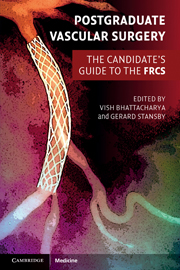Book contents
- Frontmatter
- Contents
- List of contributors
- Preface
- Section 1 Final FRCS vascular clinicals
- Section 2 Final FRCS vascular topics
- 1 Vascular risk factors and their management
- 2 Management of acute limb ischaemia
- 3 Chronic lower limb ischaemia, critical ischaemia and the diabetic foot
- 4 Endovascular and surgical options for peripheral revascularisation
- 5 Abdominal aortic aneurysms
- 6 Thoracic, thoracoabdominal and suprarenal aortic aneurysms
- 7 Aortic dissection
- 8 Popliteal artery aneurysms
- 9 Femoral artery aneurysms
- 10 Carotid, subclavian and vertebral disease
- 11 Diagnosis and management of thoracic outlet syndrome
- 12 Diagnosis and management of hyperhidrosis
- 13 Chronic mesenteric ischaemia
- 14 Acute ischaemic colitis
- 15 Vascular trauma
- 16 Indications and management of lower limb amputation
- 17 Leg swelling and lymphoedema
- 18 Varicose veins and chronic venous insufficiency
- 19 Management of deep vein thrombosis
- 20 Infection in vascular surgery
- 21 Vascular malformations
- 22 Vasospastic disorders and vasculitis
- 23 Critical care considerations and preoperative assessment for general and vascular surgery
- 24 Access surgery
- 25 Basic outline of solid organ transplantation
- Index
- References
7 - Aortic dissection
- Frontmatter
- Contents
- List of contributors
- Preface
- Section 1 Final FRCS vascular clinicals
- Section 2 Final FRCS vascular topics
- 1 Vascular risk factors and their management
- 2 Management of acute limb ischaemia
- 3 Chronic lower limb ischaemia, critical ischaemia and the diabetic foot
- 4 Endovascular and surgical options for peripheral revascularisation
- 5 Abdominal aortic aneurysms
- 6 Thoracic, thoracoabdominal and suprarenal aortic aneurysms
- 7 Aortic dissection
- 8 Popliteal artery aneurysms
- 9 Femoral artery aneurysms
- 10 Carotid, subclavian and vertebral disease
- 11 Diagnosis and management of thoracic outlet syndrome
- 12 Diagnosis and management of hyperhidrosis
- 13 Chronic mesenteric ischaemia
- 14 Acute ischaemic colitis
- 15 Vascular trauma
- 16 Indications and management of lower limb amputation
- 17 Leg swelling and lymphoedema
- 18 Varicose veins and chronic venous insufficiency
- 19 Management of deep vein thrombosis
- 20 Infection in vascular surgery
- 21 Vascular malformations
- 22 Vasospastic disorders and vasculitis
- 23 Critical care considerations and preoperative assessment for general and vascular surgery
- 24 Access surgery
- 25 Basic outline of solid organ transplantation
- Index
- References
Summary
Key points
Aortic dissection may be defined as acute (<2 weeks since symptoms) or chronic (>2 weeks since symptoms)
Acute aortic dissection is associated with hypertension and pre-existing disease of the aortic wall
Patients usually present with severe, tearing chest and back pain
Diagnosis is with transoesophageal echocardiogram and computed tomography (CT) angiogram
The Stanford or DeBakey classifications are used to describe the pattern of dissection
Type A dissections require early surgical treatment. The in-hospital mortality is high but the prognosis is very good in patients surviving to discharge from hospital
Type B dissections are treated medically in the first instance. The in-hospital mortality is much lower but complications may occur following discharge
Chronic type B dissection may result in aortic dilatation and rupture so surveillance is required
Endovascular strategies have a role in some situations for acute type A dissection and acute type B dissection, but the role in chronic type B dissection is unclear
Epidemiology
Aortic dissection occurs with an incidence of approximately 3 per 100,000 per year. Accurate estimates are difficult due to the high out-of-hospital mortality for this condition and the low post-mortem rate in most countries. It affects males twice as commonly as females and the risk increases with age. Interestingly, as with a number of other cardiovascular conditions, it demonstrates circadian variation with a peak incidence early in the morning and during the winter. This pattern correlates with times of peak blood pressure.
- Type
- Chapter
- Information
- Postgraduate Vascular SurgeryThe Candidate's Guide to the FRCS, pp. 108 - 114Publisher: Cambridge University PressPrint publication year: 2011



